- Two new options open to engineers
- Of ptarmigans, isotopes, and actuaries
- A mastodon in a biscuit box
- Editor:
- Chris Redmond
- Communications and Public Affairs
- bulletin@uwaterloo.ca

This is how the future looks. These three "future grads" got a good look at things in the Ontario Science Centre in Toronto last Sunday, during an alumni outing at the OSC. Photo: Neil Trotter
Two new options open to engineers
Here’s a curriculum change that was approved by the university senate back in March but may not be widely known across campus: the introduction of two “options” that will be available to students graduating in engineering. “These new options were developed in collaboration with the Faculty of Science,” said documentation submitted to the senate, “in order to improve the availability of options, particularly for nanotechnology engineering students.”
Each of the two options has a number of themes, the documentation said. “Some students in the option(s) may wish to further specialize within a given theme.”
The aim of the Option in Life Sciences, it said, “is to provide a BASc and BSE student with an understanding of the structure and function of biological systems that is both broader and deeper than can normally be attained within the context of any one engineering academic program.
“The Option in Life Sciences has four theme areas, namely, molecular and cell biology, environmental/ecological science, biophysical science, and biochemical science. Each theme has four required foundations (or core) courses, plus three elective courses to be selected from a set of at least seven Faculty of Science courses in the particular theme area.
“Although this option is available to all students in the Faculty of Engineering, it is expected to be of particular interest to students in the chemical engineering, environmental engineering, nanotechnology engineering, and systems design engineering programs.”
The aim of the Option in Physical Sciences is “to provide a BASc and BSE student with an understanding of the basic physical sciences that lie behind many engineering applications that is both broader and deeper than can normally be attained within the context of any one engineering academic program.
“The Option in Physical Sciences has three theme areas, namely, physics, chemistry, and earth and environmental sciences. Each theme has four required foundations (or core) courses plus three elective courses to be chosen from a set of at least ten Faculty of Science courses in the theme area. Sub-themes may be followed by making judicious choices of three elective courses. This option is available to all students in the Faculty of Engineering.”
Of ptarmigans, isotopes, and actuaries
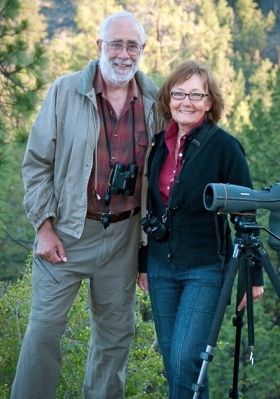 The Ptarmigan’s Dilemma: An Exploration into How Life Organizes and Supports Itself, (McClelland & Stewart, March 2010) comes from John Theberge, a retired professor of ecology and resource management in Waterloo's environment faculty, 1970-2000, and his wife Mary Theberge, a wildlife illustrator and researcher.
The Ptarmigan’s Dilemma: An Exploration into How Life Organizes and Supports Itself, (McClelland & Stewart, March 2010) comes from John Theberge, a retired professor of ecology and resource management in Waterloo's environment faculty, 1970-2000, and his wife Mary Theberge, a wildlife illustrator and researcher.
From the publisher’s website: “Birds that suddenly grow gall bladders, when their species has none. Moose with antlers so big they encumber their movement through the forest. Butterflies that risk extinction by overwintering en masse. These are just a few stories the Theberges tell in their examination of what the mechanisms of evolution are and how they work. With examples from the very latest discoveries in genetics and ones they have made in their own field work, The Ptarmigan's Dilemma is a ground-breaking explanation of evolution for non-scientists."
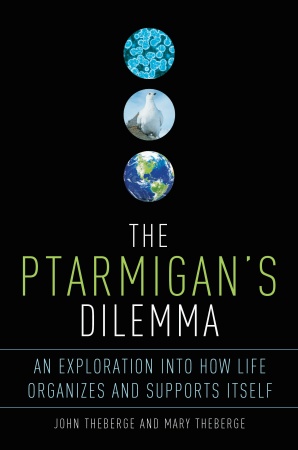 A Globe and Mail review by Michael Ruse has this to say, in part: “John and Mary Theberge . . . obviously share a deep love of nature, whether it be tracking wolves in Algonquin Park or listening to bird songs out in British Columbia."
A Globe and Mail review by Michael Ruse has this to say, in part: “John and Mary Theberge . . . obviously share a deep love of nature, whether it be tracking wolves in Algonquin Park or listening to bird songs out in British Columbia."
He describes the book as "a series of reflections about nature, informed on the one hand by evolutionary and ecological science and on the other hand given empirical substance by the writers’ huge and sympathetic understanding of the inhabitants of Canada’s forests and lakes, of its rivers and mountains and shores and more.
“Really, the important thing is to appreciate this book for the things that it does well, for these it does really well. Above all, it gives a sense of how much joy people can get from going out and looking at nature. But not just looking at it for its own sake, rather with a hypothesis or two to inform and to study and to check."
Canada’s Isotope Crisis: What Next?
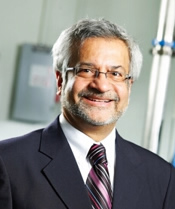 Published by McGill-Queen’s University Press, June 2010, this book is edited by Jatin Nathwani and Donald Wallace. Nathwani (right) is Waterloo's Ontario Research Chair in Public Policy and Sustainable Energy Management, and the executive director of the Waterloo Institute for Sustainable Energy.
Published by McGill-Queen’s University Press, June 2010, this book is edited by Jatin Nathwani and Donald Wallace. Nathwani (right) is Waterloo's Ontario Research Chair in Public Policy and Sustainable Energy Management, and the executive director of the Waterloo Institute for Sustainable Energy.
From the publisher's website: “Canada urgently requires a rigorous debate on the strategic options for ensuring a robust, reliable, and affordable supply of radioactive isotopes.
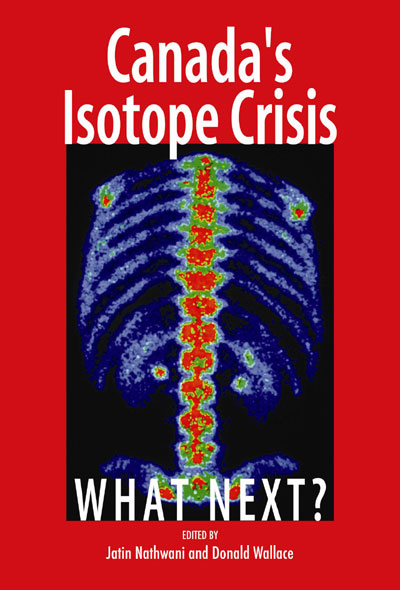 "Should the debate be confined to how Canada can best develop the necessary technologies solely for our own use or should Canada abandon the idea of producing its own isotope supply and any future aspirations to serve the global market?
"Should the debate be confined to how Canada can best develop the necessary technologies solely for our own use or should Canada abandon the idea of producing its own isotope supply and any future aspirations to serve the global market?
"Canada's Isotope Crisis focuses on the central policy question: do we dare to try to shape the future or do we retreat into silence because we are not prepared to make the necessary investments for the future well-being of Canadians?"
“This volume . . . is a multi-disciplinary effort that addresses the global dimension of isotope supply and combines expert opinions on the present and past with knowledge of the relevant government agencies and the basis for their decisions at critical junctures.”
A Short History of the Actuarial Science Program
 The front cover is bright pink — what else? — with pictures of three buildings, and the back cover assembles mug shots of 34 past and present faculty members. The volume is a 48-page Short History of the Actuarial Science Program, compiled by actuarial science professor Robert L. Brown (right) and consisting mostly of recollections by those faculty members, one by one.
The front cover is bright pink — what else? — with pictures of three buildings, and the back cover assembles mug shots of 34 past and present faculty members. The volume is a 48-page Short History of the Actuarial Science Program, compiled by actuarial science professor Robert L. Brown (right) and consisting mostly of recollections by those faculty members, one by one.
From Ian McIntosh, who started teaching Math 235 (Compound Interest) in 1960, to the recently arrived Diana Skrzydlo and Jean-François Renault, they tell the story of building a professional degree program and a research centre in one of the mathematical fields for which Waterloo is best known.
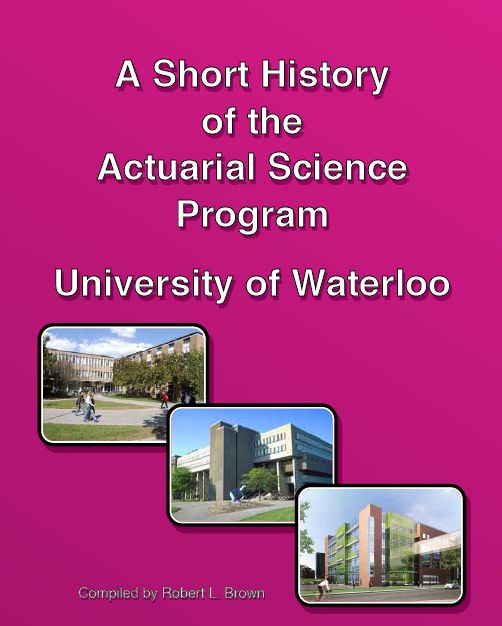 “Waterloo was a magical place to work,” recalls Harry Panjer, 1975-1976 and 1980-2008. There are personal anecdotes, professional tributes from one faculty member to another, and recollections of moving vans — including Gord Willmot’s transfer from Waterloo to the University of Toronto in 2000 and his return a year later when a research chair was created for him.
“Waterloo was a magical place to work,” recalls Harry Panjer, 1975-1976 and 1980-2008. There are personal anecdotes, professional tributes from one faculty member to another, and recollections of moving vans — including Gord Willmot’s transfer from Waterloo to the University of Toronto in 2000 and his return a year later when a research chair was created for him.
The book begins with an overview of the history of the university (and the Faculty of Mathematics) and closes with a note about Mathematics 3 building, now under construction, and the recognition of Waterloo as a Centre of Actuarial Excellence by the actuarial profession.
The first half of the book is available online as a pdf. To get the complete book, contact Karen Dmyterko. There will be "a nominal fee" of $10.
A Mastodon in a Biscuit Box
“The museum receives some wonderful donations from time to time that open up the door to a fantastic story,” says Peter Russell, curator of the Earth Sciences Museum.
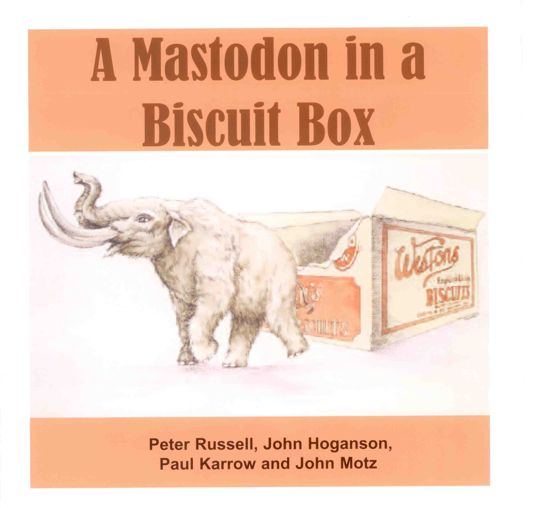 Peter is speaking in reference to the recently published booklet entitled A Mastodon in a Biscuit Box, which investigates the finding of mastodon teeth by Shirley Fenton, managing director of WIHIR.
Peter is speaking in reference to the recently published booklet entitled A Mastodon in a Biscuit Box, which investigates the finding of mastodon teeth by Shirley Fenton, managing director of WIHIR.
Mastodons were hairy, elephant-like animals that roamed southern Ontario 13,000 years ago. After finding the teeth (which Shirley initially thought were bones) she contacted Peter and he did some research on the teeth that led him to discover the story of the Highgate Mastodon, the most complete mastodon ever found in Ontario, which happened to be uncovered by Shirley’s relatives, William and John Reycraft.
The story explores whether there is a link between the teeth Shirley found in the attic and the Highgate Mastodon.
Along with Paul Karrow, retired professor in the Department of Earth and Environmental sciences, Peter has given many lectures to groups in southern Ontario about Shirley’s find, which has created a lot of public interest.
Last summer, they gathered all the data about the history of mammoths and mastodons in Ontario and began to write the booklet. John Hoganson, state palaeontologist for North Dakota, and John Motz, volunteer at the Earth Sciences Museum, also authored the story.
“This is a story of luck, greed, misfortune and science,” Peter says. “You will have to read the booklet to see how it all turns out.”
The booklet, aimed at ages 9 and up, is being sold for $5.50 and can be found at the University of Waterloo Bookstore, Words Worth Books in Waterloo, and Reader's Haven in Tobermory.
CPA staff
We want to hear from you
How is the Daily Bulletin doing? Please take a few moments to fill out this confidential and anonymous feedback form.
Link of the day
When and where
Class enrolment on Quest for fall term courses: open enrolment began July 26.
Library hours for spring exam period, July 25 to August 14. Davis Centre open 24 hours a day, except closed Sundays 2 - 8 a.m. for system maintenance. (Dana Porter open regular hours: 8 a.m. - 11 p.m., Monday-Friday; 11 a.m. - 11 p.m., Saturday and Sunday.)
Quantum Cryptography School for Young Students, July 26-30, Institute for Quantum Computing. Details.
Hot water will be off in School of Pharmacy labs today, 8 a.m. - 12:01 p.m., to allow tank inspection.
Surplus sale of university furnishings and equipment today, 12:30 to 2:00, East Campus Hall. Details.
International spouses monthly gathering today: meet at 1 p.m. at main entrance to Lion’s Lagoon in Waterloo Park for potluck picnic. Details.
bohmLAB workshop open house, Friday, 1 - 6 p.m., Grand Studios, 7-112 Grand Avenue, Cambridge, across from School of Architecture.
Intercountry Adoption Summit hosted by the arts faculty: September 23-26, Stratford. Early bird registration rate up to August 1. Details.
Civic Holiday Monday, August 2, UW offices and most services closed, classes not held.
Feds Used Books opens on Saturdays in addition to regular weekdays through August, 9 a.m. - 5 p.m. Details.
Spring term examinations August 3-14 (online courses, August 6-7). Unofficial marks begin appearing on Quest, August 16. Marks become official September 20.
Employer interviews for co-op programs, main group, August 3 - 6.
Co-op job postings, main group, for fall 2010 work terms, on JobMine August 3 – 9; daily postings thereafter.
Men’s hockey “shooting to score” camp for boys 5-14, August 3-6, 16-20, 23-27, August 30 to September 3, Icefield. Details.
Centre for Teaching Excellence workshop: “Course Design”, Thursday, August 5, 9:30, Flex Lab, Dana Porter Library. Details.
Ontario Mennonite Music Camp for students aged 12 to 16, August 8-20 at Conrad Grebel University College. Details.
Road just north of MC building and building's loading dock will be closed to vehicles and pedestrians, except emergency vehicles, 7 a.m. to 4 p.m. daily starting August 9, for about two weeks, to install steel structure for new math bridge.
Selected Areas in Cryptography Conference, August 12-13, Centre for Environmental and Information Technology room 1015. Registration/reception August 11. Details.
UWRC Book Club discusses The Pillars of the Earth by Ken Follett, Wednesday, August 18, 12:00, Dana Porter Library room 407.
St. Paul’s University College Masters Golf Tournament, Friday, August 27, Glen Eagle Golf Club, Caledon. Details.
Fall term fees due Monday, August 30 (fee arrangements), September 8 (bank payment). Details.
Women’s basketball back-to-school camp August 30 through September 3, Physical Activities Complex. Details.
WatCACE financial support for research on co-op: proposals deadline September 1. Guidelines.
Labour Day holiday Monday, September 6, UW offices and most services closed, classes not held.
PhD oral defences
Chemical engineering. Monrudee Phongaksorn, “The Development of Ni1-x-yCuxMgO-SDC Anode for Intermediate Temperature Solid Oxide Fuel cells (IT-SOFCs).” Supervisors, Eric Croiset and Stephen Corbin. On display in the Faculty of Engineering, PHY 3004. Oral defence Thursday, August 12, 9 a.m., DWE room 2534.
Management sciences. Rakinder Sembhi, “Capabilities Enabling Product Orientation and Service Orientation: A Study of Canadian Software Firms.” Supervisor, Rod McNaughton. On display in the Faculty of Engineering, PHY 3004. Oral defence Thursday, August 12, 9:30 a.m., CPH room 4333.
Psychology. Kelly Malcolmson, “Towards a Theory of Visual Concealment.” Supervisor, Dan Smilek. On display in the Faculty of Arts, PAS 2434. Oral defence Friday, August 13, 10 a.m., PAS room 3026.
Chemistry. Laura J. Ingram, “The Synthesis of Sulfated Carbohydrates Using a Sulfate Protecting Group Strategy.” Supervisor, Scott Taylor. On display in the Faculty of Science, ESC 254A. Oral defence Thursday, August 19, 9:30 a.m., Chemistry 2 room 361.
Physics and astronomy. Ting Lu, “GalaxyTransformations in the last Five Billion Years.” Supervisor, Michael Balogh. On display in the Faculty of Science, ESC 254A. Oral defence Friday, August 20, Physics building room 352.
Health studies and gerontology. Norma Jutan. “Integrating Supportive Housing into the Continuum of Care in Ontario.” Supervisor, John Hirdes. On display in the Faculty of Applied Health Sciences, BMH 3110. Oral defence Tuesday, August 24, 9 a.m., BMH room 3119.

